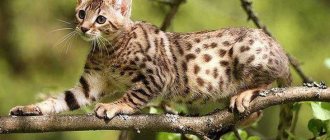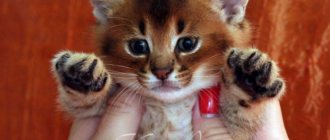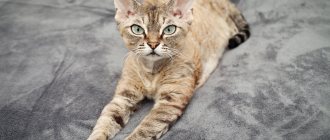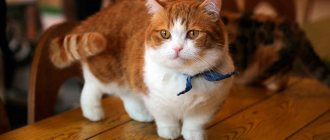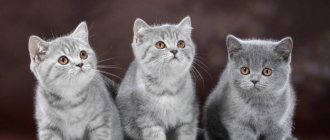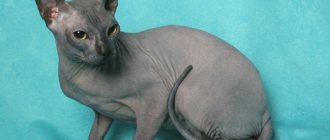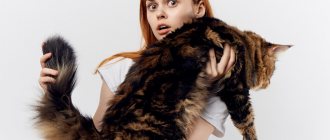Save the article:
One of the most independent cats in character, they are so imposing and beautiful that their royalty has not been disputed for a long time. There are different versions talking about the reasons for their independent character and the birth of British cats . A gray fur coat, amber eyes, thick undercoat and a stern, piercing gaze into the very soul - this is what the British cat breed is. These are one of the most beloved cats in the world, who enjoy human love quite rightly.
History of the British cat breed
And now it is not known exactly how British cats appeared. There is an assumption that back in the first century BC. The ancient Romans brought such cats to England. The density of the coat contributed to the fact that the animals were able to adapt in the shortest possible time to the conditions of a different climatic zone. For a long time, these cats hunted small rodents, demonstrating their excellent hunting qualities.
In the 16th century, breeders became interested in the bright appearance of British cats. In 1871, the British breed was represented at the first international cat exhibition, held in Great Britain, in London, by a blue British cat and became the winner there. During the same period, standard breed indicators began to be developed, and mass breeding of British cats began.
The beautiful appearance of British cats has attracted the attention of breeders
To achieve ideal standard indicators, especially beautiful British cats took part in the selection. in mating, giving the British a rounded, slightly flat muzzle. Participation in wars led to the decline of representatives of the British breed, and in order to preserve it, breeders began to breed the British with similar breeds of cats: Scottish, Chartreux, Burmese, Russian Blue.
The breed of British cats is among the breeds that have not experienced strict selection.
The year 1980 was marked for the breed of British cats by receiving the championship title. The development of standard British indicators was completed. It was the first breed in the UK, officially registered in 1980. The breed is recognized by the largest felinological organizations in the USA and Europe.
Interesting Facts
White British Shorthair cats are unusual. There are a number of unusual facts that few people know about, but in vain.
Among these:
- Short-haired breeds do not have eyelashes on their eyes. In addition, the eyeballs are located disproportionately in relation to the body, but this does not in any way affect the visual perception of the world by animals.
- Cats have excellent hearing. This is possible due to the nerve endings located in the eyes, due to which any noise immediately enters the auricle.
- The British have an excellent sense of smell, which is fourteen times stronger than that of other felines. This is due to the antennae, which are also responsible for the sense of smell.
- Representatives of the breed are real sleepyheads, because they must sleep at least 14-16 hours a day to recuperate. Some animals spend 18-20 hours sleeping.
- The British are hardy animals, four-legged excellent hunters and can easily catch a mouse or rat.
- Cats rarely meow, which is explained by their reserved and calm nature.
Regardless of what kind of British dog you buy: white, with a silver tint, black, brown or with a different coat color, he will become a true friend and family favorite.
Did you like the article?
Features of British breed cats
Typical features that characterize cats of this breed include: a large head, strong paws, a massive body with a large bone system.
British cats have a large head, massive paws and body
Appearance
The British cat is a medium-sized animal, with a benevolent look on its round face, plush dense fur, and a wide variety of colors. When comparing British cats and cats, the former look more massive. These animals are characterized by slow development, they reach maturity by 4 years. To distinguish an ordinary cat from a purebred animal, one should refer to systems of international criteria.
CFA System Standards
There are different felinological systems in the world with their own standards regarding the appearance of animals. In accordance with the standard indicators established by the CFA felinological system, animals of this breed belong to the type of cats that are strong, harmoniously developed, with a large chest. A characteristic feature of the breed is the squat appearance of the animals, which is given to it by short legs.
Representatives of the British breed are harmoniously developed
The standards of the American system, in addition to CFA, are followed by TICA. American breeders have the main requirement for the animal's physique; in addition to the American one, there is a European system of standards (WCF, FIFe, FARUS systems), which pays special attention to the color of cats. However, the general appearance of the British breed cats indicated above is the same for the standards of all systems.
Structural features
In more detail, the body parts that make up the structure of British cats can be described as follows:
- The animal's head is large and round, which is noticeable when looking at the cat from the front. It is quite large, set on a thick, short neck. The cat has a convex forehead. The cheeks are thick and dense, well defined. The nose is wide and of medium size. It is straight, with a slight depression on the bridge of the nose, noticeable in profile. The cat's nose, together with a straight chin, forms a vertical line.
- The muzzle is well developed, wide at the cheekbones, and ends with a massive chin.
- The ears are of medium size, set far apart from each other on the head and do not disturb its roundness. They are wider at the bottom and their tips are rounded.
- The eyes are large and round. They are located straight and wide on the muzzle. Well opened. Their color is influenced by the color of the cat's fur.
- The animal has a medium-sized body, it is stocky, squat, and proportional. Cats have a short straight back, a wide chest shape, and strong and heavy shoulders.
- The paws are thick, small in height, with a strong bone structure, rounded, strong pads on the paws. The cat's forelimbs are straight.
- The animal's tail is not very long. It is thick at the base and rounded at the end.
- Dimensions. At any age, animals of this breed have a compact build. They finally gain weight at about 3 years of age. It has been noticed that cats with a single color are larger than cats with different colors. For males of the breed, the weight ranges from 5 to 8 kg, for castrated ones it is about 12 kg. Females weigh from 3-4 kg, sterilized - up to 7 kg. The height of the animals at the withers reaches 33 cm.
Features of wool
According to the standard, British cats have rather dense, short hair. The coat should be uniform in density and length, with a thick undercoat, elastic to the touch, and not too soft. The British coat should be shiny.
The British fur coat is thick and shiny.
British color
According to the standard, British cats have dozens of different colors. Solid colors are not necessary at all. Even with a solid color, deviations in the uniformity of coloring of the fibers are possible, expressed in the manifestation of different tints, haze, and shadedness. Among the colors allowed by the standard are:
- Plain. Among them: Blue. This is a common classic color. With it, the cat's fur and skin are blue, the undercoat is lighter than the main color. The lighter the color, the more valuable the cats are. In adult blue cats, the eyes become a rich amber color.
- Black color is less common, since by the age of one year the color of the coat can turn from black to brown. This is due to heredity.
- Lilac. It is a complex combination of tones, which includes blue, pink and gray shades.
- Chocolate. Wool of this color looks like fur on a mouton fur coat.
- The red, ginger color is the result of crossing British cats with exotic Persian cats and other breeds with reddish shades of fur.
- Cream. This solid color comes in a predominantly pale cream tone.
- White. There is a risk in getting healthy offspring from white British cats, since the kittens may be born deaf.
Photo gallery: different colors of British cats:
Beautiful British black cat. Blue color is classic for the British.
The color of British cats is lilac
A chocolate cat looks like a teddy bear
The red color of the British cat resembles the sun
Elegant cream colored kitten
White Brittany is beautiful but rare
The shaded silver color of the cat casts silver
Tortoiseshell color occurs in females
British bicolor
Particolor British breed cat
Lilac harlequin cat
Color of the British Van cat breed
The smoky color shimmers and silvers when the cat moves. Tabby-colored cat with a marbled pattern.
The Siamese pattern is a prime example of the color point color.
Golden shaded cat
The British have some shortcomings. These include:
- too long fluffy coat;
- various birth defects;
- elongated body shape;
- fuzzy jaw lines;
- colors with various inclusions of other colors.
The animal may not meet the standards and will be disqualified. This is possible when:
- the eye color does not match the main color of the animal;
- there are flaws on the tail;
- spots in the armpit or groin;
- disturbances in color, pigmentation of paw pads, nose;
- the number of toes on the paws does not correspond to the norm;
- malocclusion;
- obvious signs of illness.
Health, life expectancy
The British are representatives of an aboriginal breed, and therefore they have no hereditary diseases or congenital pathologies. These animals have good immunity and do not get sick if properly cared for. At 5 months, their eyes may become watery, but usually severe lacrimation goes away on its own, without the use of medications.
British cats have good health
Prolonged exposure of a British cat to drafts can cause it to develop a cold. If such an animal is not fed properly and its teeth are not brushed, this can cause gingivitis and the appearance of tartar.
In rare cases, Britons are susceptible to the following diseases:
- hemophilia (chronic bleeding, severe disease due to decreased blood clotting);
- nail fungus;
- hypertrophic cardiomyopathy.
Character, habits of the animal
British cats have an independent character. Its negative feature is its independent decision-making, which often does not correspond to the opinion of its owner. Outwardly, the Briton is indifferent to affection, he does not ask to be held, does not suck up, and behaves rather reservedly with his owner. However, during separation from him, the cat misses its owner and waits for his return. But the pet communicates with its owner depending on its mood: it will not be possible to pet it by force.
Despite the outward seriousness of the British, they are called the most life-loving and positive animals. It has been noticed that cats of the British breed, thanks to their very plump cheeks and protruding tongue, are able to smile, and this sets them apart from other felines.
British cat smiling
British people cohabiting with other animals and people
Cats of this breed are characterized by sociability and friendliness. They treat all family members who love them well. In the house they get along peacefully with other animals that do not show intrusiveness towards them. The British love children. However, they do not tolerate familiarity. Their independence of character and low maintenance make these cats ideal companions for people who spend a lot of time at work. Representatives of the British breed are often called “cats for businessmen.”
The British are not known for their aggressiveness. They avoid open conflicts and simply withdraw when quarrels are brewing. The intelligence inherent in these animals does not allow them to bite and scratch when communicating with household members. British cats perceive guests rather coolly and try to move away.
The British reserve does not interfere with their playfulness. During the game, they do not misbehave or cause damage to interior items. Cats meow quietly and rarely. They can communicate with their owner by making louder sounds.
From the experience of communicating with a British, gray long-haired cat called Epifan, who is 5 years old; we can conclude that this cat, as a true representative of the British breed, is quite friendly, inquisitive, and sociable. He adores his owner, misses her and rejoices at her return. Passionately loves to play. He doesn’t like to sit in his owner’s arms and sits next to him. The cat likes to be at the dacha and explore the territory of the dacha.
Colors with white
A cat can have any of the following colors: black, blue, lilac, chocolate, red, cream, cinnamon and fawn, as well as a combination of these plus white spots. One fourth (no less!) part of the body should be white - this is the chest, front legs, cheeks, and belly. The nose and paw pads should match the base color.
Classic color with white
Strictly speaking, this is a two-colored cat. Elegant white spots (yellowishness is not allowed) and a fur coat of any of the classic colors. The nose and paw pads match the base color.
Smoky color with white
The cat has a symmetrically and harmoniously distributed white color (chest, paws, cheeks) and “smoky” spots of any color.
Color point with white
The elegant coat of such a cat is painted in two colors: white and any of the palettes with point marks. The chest and front legs are white, and there are also white spots on the cheeks. The symmetry of white spots and their harmonious arrangement are appreciated. Markings of black, blue, lilac, chocolate, red, cream, cinnamon and fawn. The nose and paw pads match the base color.
Colors with white tabby
The same patchwork turtles, only some spots may have a tabby pattern. Rarely seen, it is considered a combination of three colors. There may also be spots of the same (any) color, on which a tabby pattern appears (stripes, spots, marble).
Types of British cats
Representatives of this breed may differ in appearance. Depending on this, several varieties are distinguished.
British fold cat
You can often find references to British fold cats. However, not a single felinological organization has a description of such a breed. The British Fold cat does not exist. This phrase combines two breeds: the British Shorthair with standard ears and the Scottish Fold. Kittens with folded ears (fold ears) are obtained only from cats of the Scottish breed; kittens born also belong to this breed.
Fold cats are not of the British breed, but only of the Scottish breed
British Longhair
This type of British cat breed was the result of crossing the British and Persians. This type of British cat is recognized as a separate breed and is admitted to exhibitions by the International Cat Organization (TICA) and the World Cat Federation (WCF). These cats have straight, medium-length fur, as well as fluffy “pants” and a “collar”.
The British Longhair is similar to its shorthair variety, but its fluffy “pants” and “collar” give it away
Such animals with any coat color are allowed to participate in exhibitions, with the exception of snow-white mixed with color point.
British Shorthair
This type of coat is considered the breed standard. In its density and tenderness it is comparable to bear fur. The coat of the British Smooth-haired is thin, similar to plush wool. The hairs have the same length, averaging 2.4 mm.
British Shorthair cats have fur that resembles a bear's skin.
Deviations in the structure of the coat can be an obstacle to the participation of such cats in various exhibitions.
Video: British Shorthair cat breed
British chinchilla
British cats have recently developed a variety called the British chinchilla. Chinchilla is not the name of the breed, but a type of coat color of British cats. This is an artificially bred variety of British cats that has an original exotic color, reminiscent of the fur of rodents of the same name. This color is considered one of the most valuable and rare.
British silver chinchilla, owner of a rare color
British chinchillas have 3 types:
- with a golden color, when the color of each hair turns from black to light brown or peach;
- with a silver color, the color of the hairs changes from white to black, the coat seems to be covered with a light black veil;
- with a silver shaded color, in which the color is darker because there is a higher percentage of black hairs in the coat; Animals with this color often have black stripes on their tails.
Among these chinchillas there are short-haired and long-haired. All of them have thick hair and a dense layer of undercoat, but the color of short-haired chinchillas is more clearly expressed. In long-haired ones, it is more tender and softer.
British cats are often called British Straights because their ears are set straight on their heads. They should not be confused with Scottish straight kittens (straights), which appear in Scottish Fold litters along with babies with curled ears.
Straight-eared kittens also appear in Scottish Fold litters, but they are not British, but Scottish
Smoky colors
“Smoky” can be any of the colors, the main thing is that the undercoat should be lighter than the main color, preferably white. This is one of the varieties of hair color distribution. About half of the hair is colored, and closer to the root half is white. There are also “cameo” colors, in which the color of the undercoat almost merges with the color of the main hairs.
Classic smoky
“Smoke” is superimposed on the same solid coat colors: black-red, chocolate-red, blue-cream, lilac-cream, as well as cinnamon-red and fawn-cream. The undercoat is silvery-white.
Smoky bicolor
The cat has a symmetrically and harmoniously distributed white color and “smoky” spots of any color. The undercoat is white, the nose and paw pads match the base color.
Contents and features of caring for British cats
The British breed of cats does not require special care, so keeping them is not associated with any difficulties. Caring for your pet is as follows:
- Combing the coat with a massage slicker brush, this should be done twice a week. With this procedure, dead hair is removed and a kind of massage is performed.
- Short-haired cats can be washed 1-2 times a year or as needed. Long-haired pets require water treatments more often.
- After 2 weeks, an adult cat should have its claws trimmed to ½ of their length.
- Remove natural discharge from the eyes daily using a cotton pad, moving from the outer corner of the eyes to the inner corner.
- The cat's ears must be examined every two weeks, and accumulated wax must be removed with a cotton swab or disk moistened with a hygienic solution.
- Every day you need to examine the animal’s oral cavity in order to promptly detect tartar or other pathologies. To prevent them, a kitten should be taught to brush its teeth from a young age.
- Balanced and proper nutrition. It has a great influence on the health and appearance of British cats. The food should contain all the nutrients, vitamins and microelements the cat needs. The diet may include ready-made balanced feeds or natural products. The cat’s nutrition depends on the age of the animal, its state of health, and preferences.
Caring for a cat requires regular trimming of its claws.
To maintain normal cat health, he will need annual preventive examinations at a veterinary clinic and timely vaccination.
When to adopt a kitten?
The ideal age for moving to a new family is 3 months (12 weeks). During this time, the kitten receives the necessary nutrition from the mother, breast milk actively builds immunity, and also allows the baby to develop properly. It is at this age that kittens already weigh about 2 kg. Also at this age, kittens learn from their mother the rules of behavior and caring for their appearance. A responsible breeder provides the necessary vaccinations up to 3 months and carries out preventive work, treating babies against helminths.
The ideal age for a kitten to move to a new family is 3 months.
Features of mating and breeding
Breeding British breed kittens should be done by someone with experience. The peculiarity of mating is that the blood of the male and female must be of the same type - A (in most cats) or B, which is typical for a small percentage of pets, otherwise a conflict between different types of blood in the parents will lead to the birth of non-viable offspring. To avoid this, breeders conduct special testing on cats before they reach puberty.
In the UK, puberty occurs when they are 7–9 months old. However, the most favorable period for the first mating with a cat occurs between 10 and 18 months, when the cat’s body is strong enough to endure childbirth without harm to health.
How often do British cats go into heat, its duration
You can tell that a cat is in heat by her behavior. She becomes affectionate with male representatives, arches her back, and meows loudly. The interval between estrus in cats varies, on average it ranges from 15 to 20 days; estrus lasts 7–9 days. During estrus it is recommended:
- Do not give medications that can suppress the cat's heat. This can result in hormonal imbalance and the formation of tumors.
- Wait out the cat's first two heats, and on the third, take her to the groom, preferably the next day after the start of the heat.
- For the first mating, find a cat with experience so that he can cope. if the cat shows obstinacy.
- You should not mate cats and cats that do not have experience in this matter, otherwise you may need the help of the owners, which will take more time.
A young cat needs to choose a cat with experience who understands why she was placed with a cat. Mating should be carried out with a cat whose coat color matches the color of the cat's coat. There is no need, for example, to mate a purple cat and a black cat. Otherwise, the kittens may turn out to be multi-colored. This fact will not affect their health, but animals with a single color are more often suitable for exhibitions and sales.
British male and female cats must fit together
For a cat to become pregnant, 2 days of mating are enough. In order for a cat to give birth to healthy offspring, the cat should not be mated more than 3 times a year.
You can know that a cat is pregnant if she has not gone into heat after 3 weeks. Otherwise, she is again taken to the cat for mating.
Character
The white British cat is a real aristocrat.
The main character traits are:
- calm;
- restraint;
- equilibrium;
- indifference (sometimes).
Animals do not like excessive attention, they do not like to be loved and cuddled. “Business people's cats” is what they are sometimes called. These four-legged animals cope well with the absence of their owners, but greet them with great joy.
Unobtrusiveness and obedience are the middle names of these animals. Climbing on curtains, scratching their claws on furniture and getting mad - this is not about them. Once you show them a claw clipper and a toy, you can be calm.
The British get along well with children. If a child starts to pester you, the cats simply turn around and leave. Aggression is something that representatives of this breed never show.
Important! The British have a good sense of what mood their hosts are in, so they either appear at the right moment or, on the contrary, disappear.
How to choose the right British breed pet, prices, where to buy
You should not buy a British breed kitten on the street or market. For this purpose, it is better to prefer a good certified nursery. You should choose a kitten when it is 1.5 months old to look at its color, breed, and development.
When choosing a kitten, pay attention to the following points:
- his grooming;
- activity, curiosity, playfulness;
- the kitten must be healthy and well-fed;
- The baby should not hiss or show aggression.
It’s great if when choosing a kitten you can also see its parents; they should be well-groomed, healthy, and have good natural characteristics. The origin of a purebred kitten must be confirmed by its pedigree.
The health of a kitten can be determined by the following indicators:
- clear, shiny eyes; minor discharge is allowed;
- cold and wet nose;
- clean mucous membranes;
- clean ears without black spots;
- there are no creases on the tail, its surface is smooth from beginning to end;
- wool without wounds, red spots, bald spots;
- straight teeth.
When buying a kitten of the British breed, you should know how it differs from the very similar baby of the Scottish breed.
Table: external differences between kittens of the British and Scottish breeds
| Indicator name | British | Scots |
| Body structure | Stocky, squat | More graceful lines |
| Ears | Straight, erect, slightly rounded, set at a slight angle | The Scottish Straight variety has straight ears, set more vertically, while the Scottish Fold has folded ears (dropping) |
| Head | Round, well-defined cheekbones, spreading cheeks | A clear chin, an oval muzzle reminiscent of an owl's head |
| Paws | Massive, short, which gives the impression of a heavy body | Slender paws proportional to the body |
| Tail | Rounded at the end, short | Flexible, longer tail of medium thickness |
From the litter you need to choose the most well-fed and fat kitten. Its cost will be influenced by the gender, age, pedigree, and color of the animal. On average, the price ranges from 2.5 to 10 thousand rubles. If you buy a kitten from titled parents in a nursery, the price can be significantly higher, up to 30 thousand rubles.
The plumpest kitten is chosen from a cat's litter
Feeding
British cats are not whimsical and rarely go overboard with their food, but they still need a balanced diet and clean water.
Take the time to create a special diet for them, because the British have a good appetite and are prone to obesity.
If the food consists of natural products, then it is better to feed:
- beef (lean);
- chicken;
- fish (boiled);
- egg yolk;
- dairy products.
Vegetable puree from zucchini or carrots will also work.
From dry food, it is better to choose Super Premium food, as well as canned cat food, according to their age.
For example, many pet stores offer Royal Canin food exclusively for the British shorthair or longhair breed.
Reviews about the breed
My Brit is already five years old. I always wanted a purebred cat, and my friends suggested a British one. I immediately liked him when, at only one and a half months old, he already scratched me at our first meeting. It was love at first sight. Now he is already big and his character, of course, is very capricious. He loves attention, but is autonomous. It can often attack bare legs on the sly. Vengeful if he believes that he has been offended or his rights have been infringed, but he can also be affectionate. Sometimes he even tumbles and purrs. But this doesn’t happen to him very often. There is only one person who recognizes the owner, and in our family this is the mother. In general, not very whimsical. But the beauty is unimaginable. No one can pass by without being touched. Pros: handsome, smart, no complaints. Disadvantages: wayward character.
Gathrayed
https://otzyv.expert/britashku-svoego-ochen-lyublyu-1978791
My cat, my sweetie, is a British Longhair breed, with an interesting color according to the passport: shaded black silver. What can you say about character? Of course, the British are capricious, they are very, very sociable, constantly meowing and meowing something, just when they are bored, you come home and he starts talking. He eats with gusto, but in moderation, loves to go for walks when he has the opportunity to go out into nature and take him with him. He understands perfectly, but sometimes tries to show that he is the boss of the house, without being impudent; after all, we have equal rights. The older he gets, the more affectionate he becomes; he doesn’t particularly like to be held, but sometimes he allows it. Fears. True, every noise, but I don’t think it depends on the breed. The cat is long-haired, constant grooming, but sometimes at least for a show! It’s so nice when he’s waiting from work! Advantages: sociable, affectionate, understanding, loyal. Disadvantages: none.
Gated
https://otzyv.expert/britanchik-1969821
Three years ago I was given a small, fluffy ball for my birthday! To be honest, I was a little shocked; I had never had a pet before! but when we got to know him better, and it was him, I was crazy about him! He and I immediately became friends! we named him Stuart! The cat, of course, has a character, can be offended, can also conquer on the sly, prefers one owner! But the sweetness of this handsome man is off the charts, everyone is crazy about him! loves kids, the baby is capricious, he’s already nearby! Of course, appropriate care and food are necessary, he prefers to sleep exclusively with me, although his soft basket is standing next to him! Pros: pros on all sides! I love him very much! Disadvantages: not possible.
Behingleride
https://otzyv.expert/myagkiy-i-pushistiy-2046998
Wonderful kitten! ADVANTAGES: Kind, smart, very clean animals. DISADVANTAGES: Not at all tame, allows himself to be petted, but does not sit on hands. The other day my son and I went to buy a kitten. We were thinking about buying a Scottish Fold, but after looking at the kittens, we finally chose a British one. There were many colors, we liked the blue one. Bought for 6 thousand, with documents, pedigree, everything as it should be. They brought me home, and for the first day I hardly ate. But when we got used to it, we decided that we hadn’t spent our money in vain. The kitten turned out to be very smart, he knows that he needs to go to the potty, and does not throw food out of the bowl. Very clean! We were very surprised when we started bathing and the cat started jumping into the bath! If he can’t open the door, he meows and asks to be opened for him. Not picky about food. In general, buy it, you won’t regret it! The kittens are wonderful!
supernatural000
https://otzovik.com/review_3912.html
This cat is a real treasure! ADVANTAGES: Calm, affectionate, intelligent, clean, plush coat that does not require special care DISADVANTAGES: does not like to be held. There is a universal favorite in our family - a blue British shorthair cat - Vikusya. We bought her at a Moscow nursery. We followed her by train. She has an excellent pedigree and excellent breed characteristics. She is only two years old. The first advantage that pleasantly surprised me was extreme cleanliness. She always goes to the toilet in a specially designated place. There are no problems with this at all! Vikusya is very smart and loves to talk to us. When you tell her something, she looks into your eyes and responds with an intermittent meow. From the outside it looks very funny! The cat is calm, affectionate, and loves to sleep. Therefore, it is ideal for those people who are at work from morning to evening. The cat will not be bored, she will definitely keep herself busy with something. In the summer he likes to sleep on his back, with his legs spread wide in different directions. If Vikusya wants to eat, she will never scream and ask for a tasty morsel. He sits next to him and watches. Unpretentious in food. Eating dry food reminds me. When she is in high spirits, she jumps high in place and runs away. So funny! She doesn't like to be held in our arms, but she is always nearby and follows us everywhere. She wants to be aware of all the events happening in her domain! What does our favorite look like? Our favorite's head is round, with well-developed cheeks. The nose is short, wide and straight, the ears are small, and the eyes are like two huge amber balls. Her paws are thick and strong, her tail is like a carrot. A real beauty! The fur is dense, with a thick undercoat, which creates a plush effect. I love petting her! The coat does not require special care, but it is advisable to comb it once a week. I really want to visit a cat show with my pet! In conclusion, I want to say that these “teddy bears” create comfort in any home! I recommend!
Kristino4ka
https://otzovik.com/review_59095.html
Toilet training a kitten
As soon as the kitten appears in the house, you need to immediately accustom it to the new tray. At first, the baby may be disoriented in a new room and needs help. You also need to consider the location and access to the toilet, because British cats, although clean, have their own opinions. Therefore, if a kitten refuses to go to the new litter box, then you should not think that he is stupid and does not understand anything. In fact, British cats are very smart, and therefore, most likely, the new tenant simply does not like something. Perhaps the tray needs to be moved a little, moved to another corner, or the filler changed.
Instincts tell the kitten that all waste needs to be buried, so choose the appropriate substance for the toilet, because the “British” are clean. If you do not pay attention to this, the kitten may begin to mischief and look for another place to relieve itself.
Training a kitten to use the litter box
If you suddenly find a puddle on the floor, you should not scold the kitten, much less beat it; with this method of education you can provoke the baby to do things secretly in the wrong place. It is better to show your pet in a dissatisfied tone that you are not happy with this situation, and, having collected the puddle with toilet paper, take it to the tray. This way the smell will attract the kitten to go to the right place. It is also worth watching the animal; usually after the baby has eaten, he runs to the toilet. Monitor the kitten's path to the toilet, and then the baby will remember that things need to be done in the litter box.
Don't lose your temper if the kitten doesn't go to the toilet the first time. Remove puddles with special odor-eliminating products that can be purchased at a pet store. Be persistent with your pet and show him where to go, but do not hit him or scream if he suddenly misses. The kitten will sooner or later understand what is required of him, the main thing is to be patient.
In the nursery, cats teach kittens to be clean, so babies come to their new home with toilet knowledge
Price
The prices for these plush cats vary greatly:
- The cheapest British kittens can cost from $50, but it is not known whether it is worth buying for that price, and what they will eventually grow into.
- The average price for a purebred British kitten ranges from $150 to $250.
- The cost of an adult British cat, which can be used for further breeding of the breed, varies from 300 to 500 dollars.
- If you want to buy a show class cat and want to build a show career for it, then be prepared to pay up to $2,000 for it.
